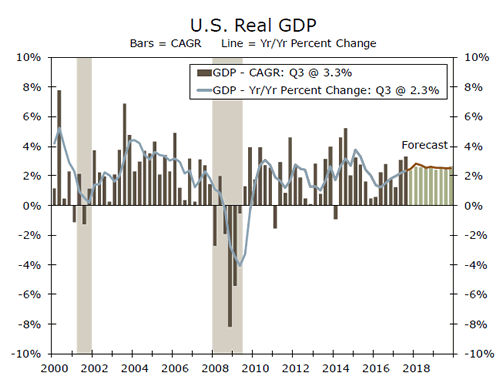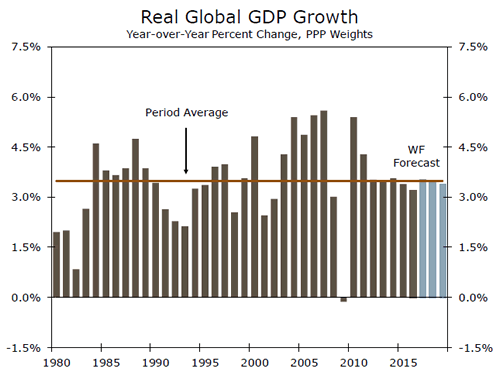U.S. Review
Retail Sales Sing Into the Holidays
- As was widely expected, the Federal Open Market Committee (FOMC) hiked rates this week. The top range of the fed funds rate now stands at 1.50 percent.
- Inflation measures started to show signs of emerging price pressures for producers and consumers.
- Retail sales for November showed that the holiday shopping season was off to a strong start. Overall sales rose 0.8 percent for the month.
- Industrial output rose 0.2 percent in November with manufacturing output also climbing 0.2 percent.
Retail Sales Sing Into the Holidays
Economic data this week continued to signal moderate economic growth and inflation started to show signs of picking up. Following November’s performance, consumer prices are now up 2.2 percent on a year-over-year basis, while producer prices are now up 3.1 percent. The more recent inflation data combined with the rate hike out of the FOMC this week showed that monetary policy normalization remains on track. With the release of our Annual Economic Outlook, we added a third rate hike into our forecast for 2018 while we kept two fed funds rate hikes in 2019. Retail sales data showed a surge in consumer spending in November to start the holiday shopping season. Industrial output also continued to rise for the month with manufacturing output posting its third consecutive month of improvement.
The FOMC hiked interest rates for the last time with Janet Yellen leading the FOMC. The committee continued to signal that evidence of inflation turning around combined with improvement in labor market conditions reinforced its view for continued normalization of monetary policy through further rate hikes and balance-sheet normalization in the year ahead.
Inflation data this week reinforced the idea that the downshift in inflation is likely behind us. The headline Consumer Price Index rose 0.4 percent in November, while core inflation climbed 0.1 percent. Energy prices helped boost the headline CPI reading while softer lodging, airfare and apparel prices held back the gains in the core CPI. Looking at producer prices, the PPI for final demand rose 0.4 percent, while the core PPI measure climbed 0.3 percent. Import prices also accelerated for the month, climbing 0.7 percent following October’s 0.2 percent increase. Even with a slightly softer core CPI reading we still see the FOMC on track to hike rates three times in 2018 as other measures of inflation continued to edge higher.
Retail sales data were one of the biggest economic data surprises of the week, climbing an impressive 0.8 percent in November. The strong start to the holiday shopping season was partially due to greater spending in electronic stores and non-store retailers, which captures online retailers. Gasoline station sales also rose 2.8 percent on the month with at least some of those gains reflecting higher prices in the nominally reported number. The retail sales control group, which feeds into the calculation of GDP, was revised higher for October and climbed an additional 0.8 percent in November. Our forecast for Q4 real consumer spending stands at 3.0 percent. If our forecasted real PCE growth materializes in Q4, consumer spending should end 2017 at 2.7 percent year over year, matching last year’s growth rate.
Industrial output climbed 0.2 percent in November with manufacturing output also climbing 0.2 percent for the month. We estimate that there will be continued growth in industrial production in 2018 with a rise of 2.7 percent on a year-over-year basis compared to this year’s expected 1.9 percent growth rate.

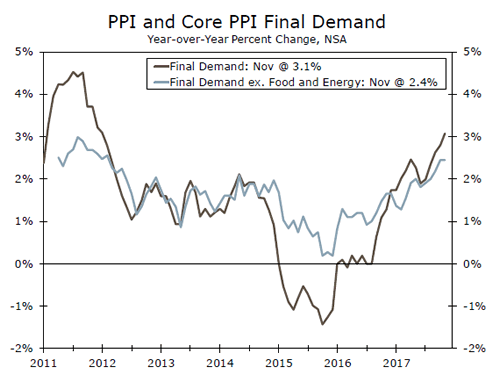

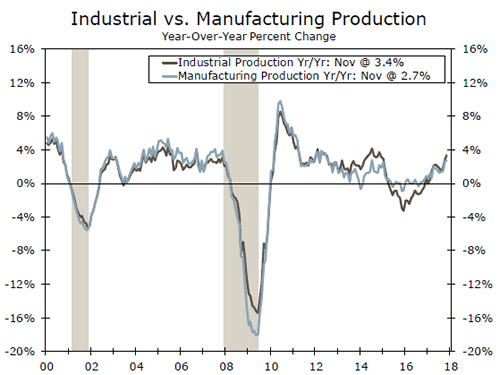
U.S. Outlook
Housing Starts • Tuesday
The rebound in housing starts in October was solid following the hurricane-induced construction stumble in September. Starts rose 13.7 percent to a 1.29 million-unit pace in October which is among the strongest months of the current cycle. This marks a strong start for residential investment in Q4 GDP, which is slated to be positive after being a drag the past two quarters.
The ramp up in construction was broad-based as only the West saw building slow, and single-family and multifamily posted solid gains. That the pace of building came back so much stronger in October than before the storms hit is an encouraging sign. The increase in permits issued combined with continued strength in builder confidence also bodes well for residential investment in coming months. Still, we are calling for the pace of starts to slow down a bit in November after October’s outsized ramp up.
Previous: 1.290M Wells Fargo: 1.237M Consensus: 1.250M
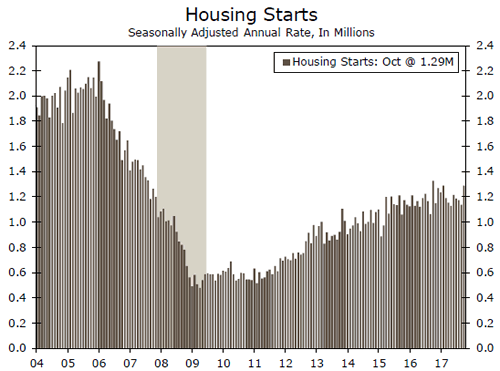
Existing Home Sales • Wednesday
Existing home sales showed a strong rebound in closings in October as weather disruptions disappeared. Contract closings rose 2 percent to a 5.48 million unit pace. October’s existing sales report suggested a good start for a Q4 rebound in residential investment in GDP. November’s resales pace likely also accelerated. We expect residential investment to be a positive contributor to Q4 economic growth after two quarters of decline.
Inventory of homes for sale continued to decline in October, which is restraining sales and pushing up selling prices. Looking through the temporary weather disruptions, the greater issue in the existing home sales market is the general lack of available inventory. This is likely to keep a significant pickup in sales activity in 2018 more difficult, although we still expect next year to be stronger than 2017.
Previous: 5.48M Wells Fargo: 5.61M Consensus: 5.53M

Personal Income • Friday
Personal income was up a solid 0.4 percent in October, while spending rose 0.3 percent. Real disposable income growth has perked up recently, which is a refreshing development following a relatively long spell of softness. Stronger income growth also came in just in time for holiday shopping, which was already slated to be strong as consumer confidence is at a multiyear high. Personal spending softened in October from a large hurricane-induced bump in September.
Inflation took a bite out of consumers’ purchasing power, as real spending rose 0.1 percent. Higher prices persisted in November, which is welcome news to the FOMC, even though it was mostly driven by energy costs. Even adjusted for inflation, we still expect that personal spending is slated for a solid increase based on the consumer confidence in recent months, October’s welcome income bump, and the strong showing for retail sales in November.
Previous: 0.4 % Wells Fargo: 0.4% Consensus: 0.4 % (Month-over-Month)
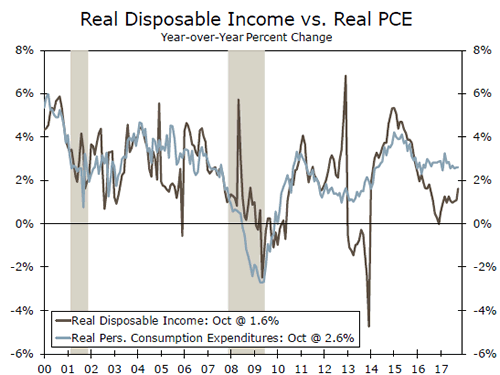
Global Review
Global Central Bank Meetings
- It was a big week for central banks as the Federal Reserve, the Bank of England and the European Central Bank all met.
- After a period in which the Fed was somewhat by itself in terms of raising rates, there is now a widening front along which other major central banks are either also raising rates or, in the case of the ECB, at least guiding monetary policy in a somewhat less expansionary direction.
Eminence Front: It’s No Put-On
The Federal Reserve was not the only major global central bank gathering this week. The European Central Bank (ECB) and the Bank of England (BoE) conducted policy meetings as well. The word ’eminence’ can be used to describe a recognized superiority within a sphere or profession as well as a piece of rising ground. This week it can be accurately used in both senses to describe central bank activity. Some of the world’s most influential central banks met this week and, to varying degrees, nudged the global economy toward higher ground in terms of interest rates or at least less-accommodative monetary policy.
Bank of England
The meeting of the BoE followed news earlier in the week that CPI inflation came in a bit hotter than expected with a 0.3 percent pickup in November that lifted the year-over-year rate of CPI inflation above the top end of the BoE’s 1 to 3 percent target range. The breach obliges BoE Governor Carney to draft a note explain the reasons behind this event to the Chancellor of the Exchequer.
Even amid this firming inflation, the growth outlook is less than certain. The year-over-year rate has been trending steadily, if only slightly, lower over the past two years. Worries about the eventual effects of Brexit have been cause for caution as well; our own forecast looks for full-year GDP growth of just 1.7 percent in 2018. The challenge for the BoE is to rein-in inflation without squeezing economic growth at a time when the outlook is uncertain.
The BoE decided at its prior policy meeting on November 2 to raise its main policy rate 25 bps, but based on language this week, the BoE’s Monetary Policy Committee (MPC) does not seem to be in a hurry to tighten further, stating that any future rate hikes "would be expected to be at a gradual pace and to a limited extent." Furthermore, the statement highlighted the downside risks to the economic outlook posed by the uncertainty of the Brexit process.
European Central Bank
As for the ECB, if raising rates is the anticipated "main event," then the "opening act" is a dialing back of its program of asset purchases. The ECB had already offered forward guidance on that front. Specifically, the ECB will purchase only €30 billion worth of bonds beginning in January 2018, and it intends to keep this monthly purchase rate unchanged through at least next September.
At its meeting this week, the ECB essentially offered no change in this guidance despite indications of firming in the Eurozone economy like the PMIs, which have climbed to multi-year highs for the services and manufacturing sectors.
If the overall rate of inflation in the Eurozone trends slowly higher in the months ahead as our analysis suggests, then we think the conditions will be in place for the ECB to end its bond purchases in late 2018.
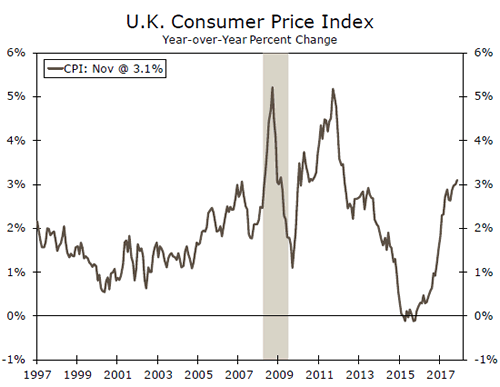

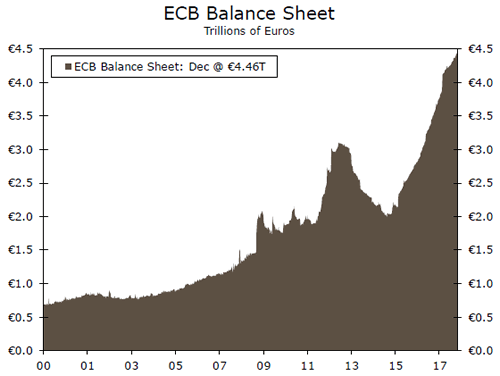
Global Outlook
Russian Real Retail Sales • Monday
Data for Russian real retail sales, real wages and industrial output all print next week. Real retail sales have climbed higher this year as the Russian economy has recovered from a deep recession that occurred over the 2015-2016 period. At its peak in early 2015, consumer price inflation in Russia was up nearly 17 percent year over year, eroding consumer purchasing power and leading to a jump in interest rates. Inflation has since receded to 2.7 percent versus a year ago.
The Russian economy has clearly improved from its recent trough, and next week’s data will likely show some continued modest progress. That said, the headwinds on the Russian economy are multi-faceted and difficult to address quickly; oil prices remain relatively low, international sanctions are in place and an aging population presents demographic challenges. As a result, although we expect some continued near-term improvement, a return to the run-rate of the early years of the past decade does not look likely.
Previous: 3.0% Consensus: 3.3% (Year-over-Year)

Bank of Japan Meeting • Thursday
Unlike many of the developed world’s central banks, the Bank of Japan (BoJ) has shown few signs of taking its foot off of the accelerator. This continued stimulus comes at a time when the Japanese economy is doing reasonably well. We expect the Japanese economy will end up growing 1.5 percent for full-year 2017. If realized, that would mark the fastest rate of GDP growth since 2013.
We do not currently envision the BoJ tightening policy in a meaningful way at any point through the end of our current forecast horizon (2019). Unlike many of the world’s other major developed economies, Japan has faced more severe deflationary episodes in its recent history in addition to struggling with severe structural challenges related to demography and other factors. Thus, we believe monetary policymakers in Japan are likely to wait until deflation and razor thin margins between expansion and contraction are banished before reversing course.
Previous: -0.1% (Policy Balance Rate) Wells Fargo: -0.1%
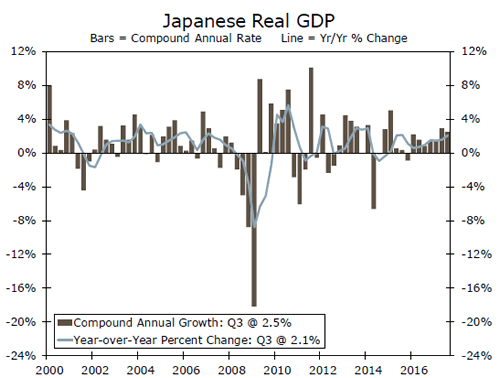
Canadian CPI • Thursday
The Canadian economy has had a strong run in 2017 as fixed investment spending rebounded after a swoon alongside oil prices. The Canadian consumer has also proved resilient despite high household debt levels. Year-over-year economic growth picked up to a 3.0 percent pace through Q3. Against this backdrop, the Bank of Canada hiked rates 25 bps twice in 2017.
The Bank of Canada targets core inflation between 1 and 3 percent. At present, core inflation is toward the lower end of this band (see chart at right). The tame inflation, coupled with high household debt levels, have led the Bank of Canada to temper monetary policy tightening expectations relative to what the growth numbers alone might suggest. We expect two more rate hikes from the BoC next year, although we believe there is some upside to this forecast. Inflation moving closer to the midpoint of the BoC’s target band would be a big factor in turning this upside risk into reality.
Previous: 1.6% (Core-Common YoY) Wells Fargo: 2.0%

Point of View
Interest Rate Watch
Inflation, Models and Belief
In recent years the upswing for inflation has been consistently below the pace anticipated by the Phillips curve model approach. Policymakers believe in this model and therefore project, represented by their dot-plot, an upswing in the benchmark fed funds rate in the year ahead. For us, we expect the FOMC to raise the fed funds rate three times in 2018 but that the pace of increases in the short-end of the Treasury curve will outpace that of the long-end, thereby prompting discussions about an inverted yield curve and its implications for a recession.
Just the Facts: Inflation
Our expectation for the path of the PCE inflation benchmark is an upward trajectory (top graph). We expect an unwinding of what we believe were largely one-off disinflationary forces in 2017 (caused by declines in wireless phone services and physician services). In addition, higher labor costs and higher energy prices as global oil demand has improved and producers remain fairly disciplined should also generate a lift to inflation. Finally a weaker dollar should generate higher import prices, all else equal.
Introduce a Model
From the FOMC’s point of view, a lower unemployment rate will lead to a higher inflation rate over time. The middle figure shows the fairly loose relationship.
Belief
Given the FOMC’s inflation model, the dotplot illustrates the path of the fed funds rate going forward (bottom graph). Our outlook is now for three fed funds rate increases in 2018. The market, however, has priced in a little less than two hikes.
Moreover, at the long-end of the Treasury curve we have an increase in rates below the pace at the short-end of the curve. The 10-two year spread declines from 69 bps to 55 bps over the first two quarters of 2018. Our 10-year to three-month yield spread declines from 114 bps to 85 bps. This imbalance in rate changes could potentially lead to an inverted yield curve – whispers surrounding the probability of a recession will likely follow.
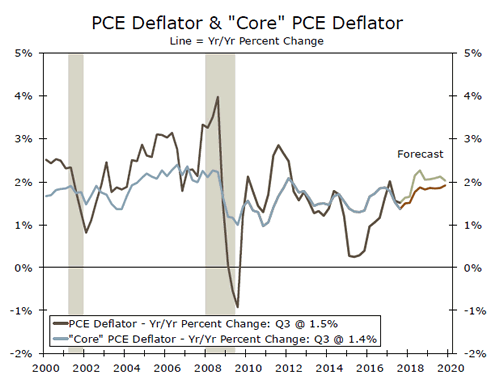
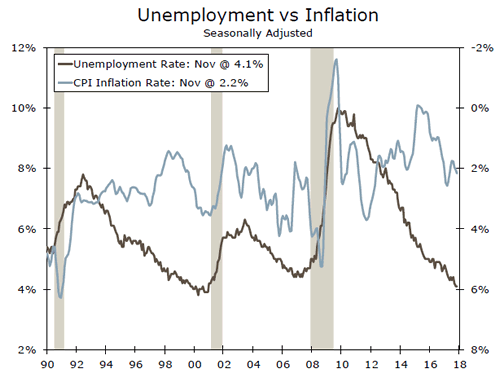
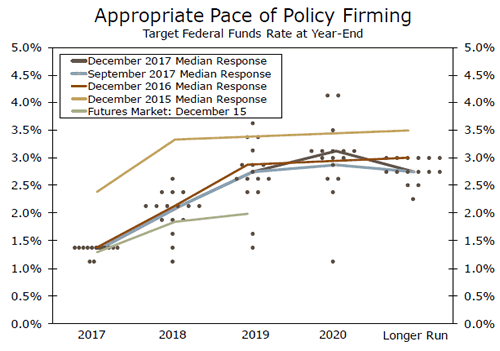
Credit Market Insights
Borrowing Remains Healthy
Consumer credit rose $20.5 billion in October, marking the largest monthly gain since November 2016. Up 6.5 percent at a seasonally adjusted annual rate, consumer borrowing in October continues to build off of the 6.1 percent gain seen in September.
Total consumer credit was supported by solid growth in revolving and nonrevolving credit. Revolving credit, up 9.9 percent at an annual rate, led the surge mainly due to increased credit card balances. Revolving credit in October also registered its largest monthly gain ($8.3 billion) since November 2016, which in part could be attributable to increased spending to start the holiday season. Nonrevolving credit, however, jumped $12.2 billion, and was up at an annual rate of 5.3 percent. The rise in nonrevolving credit was likely aided by rebound effects in auto-sales due to damage from the recent hurricanes.
Despite healthy borrowing conditions, charge-off rates at commercial banks remain on a slight upward trend. The rise in charge-off rates is in line with a rising interest rate environment, and this relationship is expected to persist as the Fed continues to tighten policy in 2018. We expect borrowing to remain healthy into the new year, as elevated levels of consumer confidence coupled with modest wage improvements continue to cause consumers to utilize credit to fund their consumption habits.
Topic of the Week
2018 Annual Economic Outlook
A Cautious Tale for an Optimistic Outlook
If we count the months since the economy emerged from recession in July 2009, this January marks the 103rd month of the current expansion. The longest expansion on record is 120 months, which was the expansion of the 1990s. Our forecast of roughly 2.5 percent quarterly GDP growth on an uninterrupted basis for 2018 and 2019 means that we are implicitly stating that this cycle will break the record for the longest expansion in U.S. history (top chart). However, with the average annual real GDP growth rate since mid-2009 at a rather tepid 2.3 percent, the current expansion will also hold the record of the weakest of the post-war era.
The unusually slow pace of this economic recovery has left the economy in pretty good shape, as there are few visible excesses present today. Similarly, for the first time in a long time just about every corner of the global economy is expanding at the same time. We are not bracing for a recession in Europe as we were in 2010- 2012 after the sovereign debt crisis, nor are we expecting knock-on effects of another great moderation in China. Instead, we are seeking slow, steady global growth, warranting no minus signs in our GDP forecasts for any of the foreign economies that we follow (bottom chart).
As global growth begins to firm, central banks are entering a period of monetary policy "convergence," rather than one of divergence. As the Federal Reserve has led the charge, we expect the FOMC to continue to tighten policy with three hikes in the federal funds rate this coming year, based on continued growth in employment and modest improvements in inflation.
Our probit model suggests a relatively low 1.17 percent probability of recession in the next six months, as it is difficult to point to a sector that has over-extended itself so much that recession is right around the corner. However, despite our admittedly sanguine assessment of the current path of the global economy, in our 2018 Annual Economic Outlook we highlight the potential risks that could warrant caution in the future.
